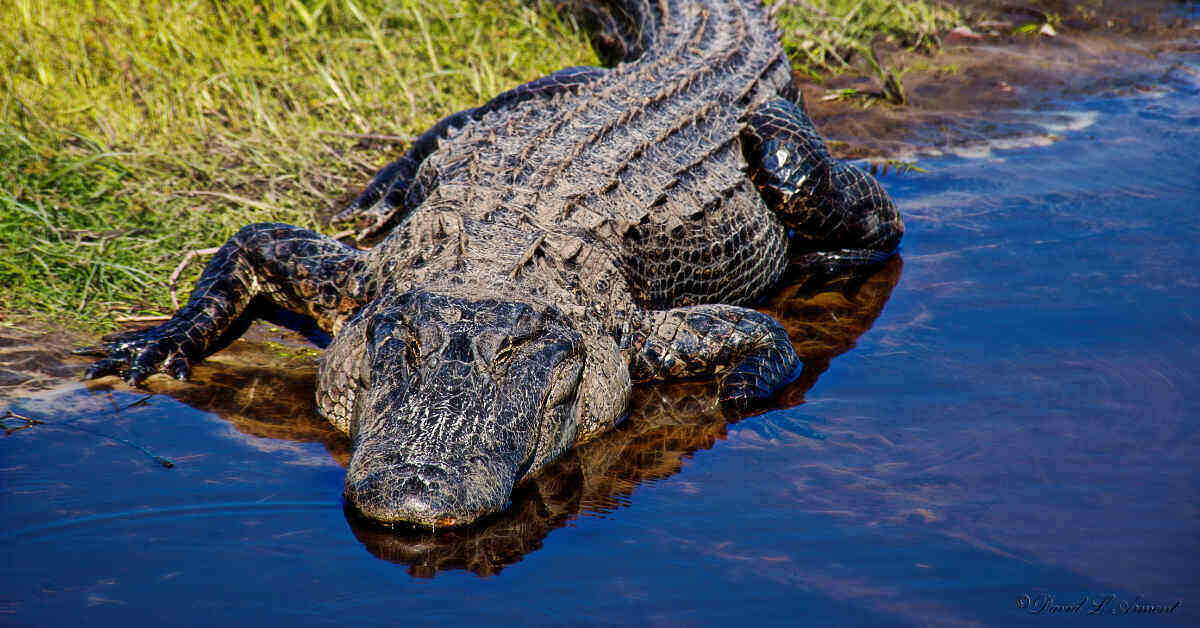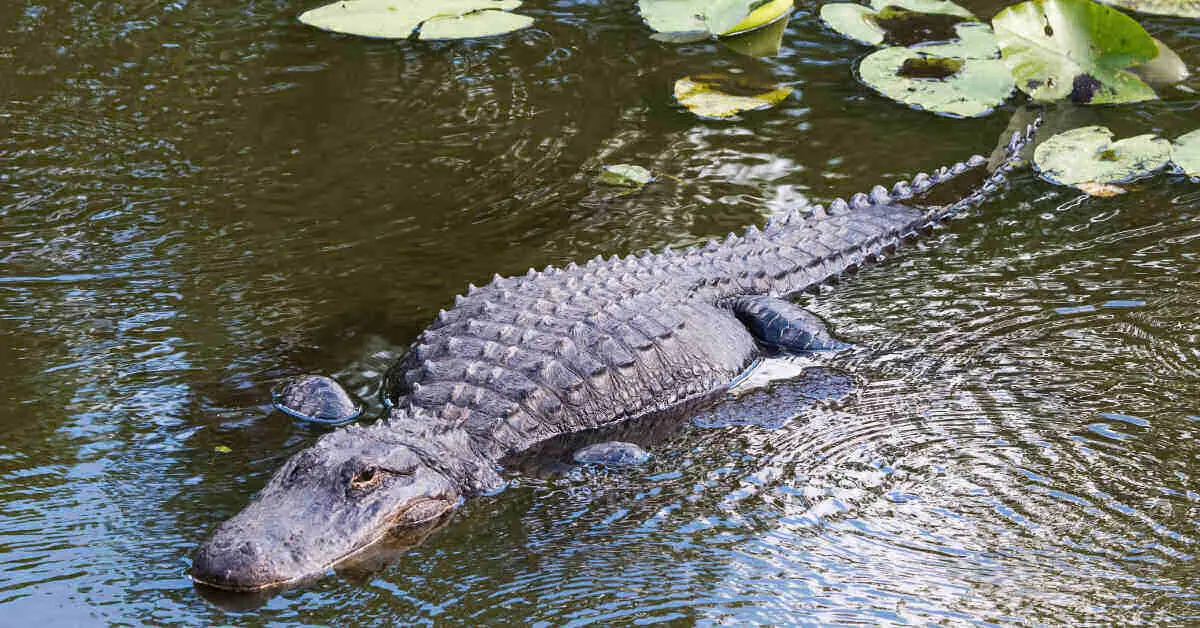As hikers, we love venturing into the wild, but sometimes nature presents unexpected surprises, like coming across an alligator! An exhilarating, yet potentially risky encounter. But don’t fret! We’re here to equip you with essential tips and strategies to handle such a situation.
Understanding Alligator Behavior
When hiking in alligator territory, be alert for signs of their behavior to guarantee your safety. Alligators are typically shy creatures and often retreat when they sense human presence.
However, if you notice an alligator approaching you, it may be displaying aggressive behavior. One sign to look out for is the alligator hissing loudly or producing a deep, low growl. These vocalizations clearly indicate that the alligator feels threatened and is warning you to stay away.
Related: What to do When you See a Mountain Lion on the Trail.
Another crucial behavior to recognize is the alligator’s body language. If you see an alligator baring its teeth, raising its head and tail, or making quick, sudden movements towards you, it’s best to slowly back away while keeping eye contact.
Remember, alligators are most dangerous when they feel cornered or provoked, so giving them space to retreat is essential for your safety.
Maintaining a Safe Distance
To maintain your safety while encountering an alligator while hiking, always keep a safe distance. Alligators are powerful creatures with impressive speed, so it’s important to respect their space to avoid any potential danger.
When you spot an alligator during your hike, remember to stay at least 30 feet away from it. This distance allows you to observe and appreciate these incredible animals without putting yourself at risk.
Keeping a safe distance gives the alligator the space it needs to feel unthreatened, reducing the chances of any aggressive behavior.
Maintaining a safe distance also guarantees that you have enough time to react and move away calmly if the alligator shows any signs of agitation.
Remember that you’re a visitor in their habitat, and it’s essential to show them the respect they deserve.

Backing Away Slowly
Slowly back away from the alligator to guarantee a safe distance is maintained. Remain calm and composed during this encounter. Here are some tips to help you navigate this situation:
– Maintain Eye Contact: Keep your eyes on the alligator to show that you’re aware of its presence.
– Move Slowly and Steadily: Sudden movements can startle the alligator, so back away at a steady pace.
– Do Not Turn Your Back: Always keep the alligator in your line of sight as you move away.
– Avoid Making Loud Noises: Stay quiet and avoid any sudden noises that could agitate the alligator.
Keeping Pets on a Leash
When hiking in areas with alligators, keep your pets on a leash at all times to guarantee their safety and the safety of wildlife.
Not only does this help prevent your furry companions from wandering off and potentially encountering an alligator, but it also safeguards they don’t disturb the natural habitat of other animals.
Related: What to do if a Moose Attacks you on the Trail
Here are some tips to keep your pets safe while hiking in alligator territory:
- Maintain Control – Keeping your pet on a leash allows you to have better control over their movements, reducing the risk of them straying into dangerous areas.
- Prevent Chasing – Alligators may see small animals as prey, so keeping your pets close can prevent them from chasing after wildlife and getting into trouble.
Avoid Disturbances: By keeping your pet leashed, you can avoid disturbances to nesting birds or other wildlife that may be easily frightened.
Quick Response: With your pet on a leash, you can quickly move them away from any potential alligator sightings, keeping them out of harm’s way.
Respect Nature: Keeping your pet on a leash shows respect for the natural environment and the wildlife that call it home.
Avoiding Alligator Habitats
To reduce the risk of encountering alligators while hiking, it’s important to be aware of and avoid their habitats. Alligators are commonly found near bodies of water such as swamps, marshes, lakes, and rivers.
These areas provide them with the food and shelter they need to thrive. When hiking, steer clear of these habitats to reduce the chances of a surprise encounter.

To stay safe, choose hiking trails that are away from known alligator habitats. Avoid areas with dense vegetation near water sources, as these can be prime alligator spots.
Keep a safe distance from the water’s edge, as alligators often bask in the sun along the shores. Remember, alligators are skilled swimmers and can move quickly both in water and on land.
Reporting Alligator Sightings
If you spot an alligator while hiking, promptly inform the appropriate authorities. Reporting alligator sightings is important for guaranteeing the safety of both hikers and wildlife.
Here are some tips on how to report alligator sightings effectively:
Stay Calm: Keep a cool head when reporting the sighting to provide accurate information.
Note the Location: Try to pinpoint the exact location of the alligator to help authorities locate and monitor it.
Describe the Alligator: Provide details about the alligator’s size, color, and any distinguishing features to aid in identification.
Avoid Approaching: Don’t attempt to get closer to the alligator for a better look, as this can be dangerous.
Follow Authorities’ Instructions: After reporting the sighting, follow any instructions given by the authorities to guarantee your safety and the safety of others.
Related: How to Avoid Snakes When Hiking
7 Interesting Facts about Alligators
1. Alligators are Remarkably Ancient
Alligators have been around for over 200 million years, meaning they once shared the world with dinosaurs! This longevity is a testament to their adaptability and resilience, traits that have allowed them to survive multiple mass extinction events.
2. They’re Cold-Blooded
Like all reptiles, alligators are ectothermic, meaning they rely on external heat sources to regulate their body temperature. They are often seen basking in the sun or cooling off in the water, depending on the weather.
3. Incredible Night Vision
Alligators possess superior night vision, thanks to a layer of cells in their eyes called the tapetum lucidum. This layer reflects light back through the retina, enhancing their vision in low light conditions – a handy trait for their nocturnal hunting exploits.
4. Alligators are Excellent Swimmers
These creatures are incredibly adept in water, capable of reaching speeds up to 20 mph with the help of their powerful tails. Yet, they can also exhibit remarkable stealth, submerging their bodies while leaving only their eyes and nostrils above the water surface.

5. They Exhibit Parental Care
Unlike many reptiles, female alligators show a high level of parental care. They guard their nests fiercely and gently carry their hatchlings in their jaws to the water upon hatching – a stark contrast to the otherwise fearsome image of these predators.
6. Alligator Communication
Alligators have a complex communication system that includes vocalizations, body language, and even infrasound – low frequency vibrations that can be felt more than heard. These signals are used in everything from territorial disputes to courtship rituals.
7. Alligator Growth Rings
Similar to trees, alligators have growth rings in their bones. By counting these rings, scientists can determine the age of an alligator, offering valuable insights into the life span and growth patterns of these fascinating creatures.
Alligators are remarkably diverse and interesting creatures. They continue to captivate and intrigue us, proving there’s always more to learn in the wild world of nature.
Final Thoughts
If you ever encounter an alligator while hiking, remember to stay calm and follow the safety tips outlined in this post. Always prioritize your safety and the safety of those around you when encountering wildlife in their natural habitat.
